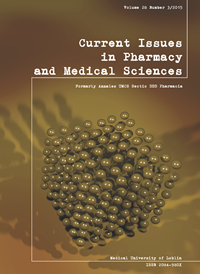Flozins, inhibitors of type 2 renal sodium-glucose co-transporter – not only antihyperglycemic drugs
DOI:
https://doi.org/10.1515/cipms-2015-0063Keywords:
type 2 diabetes mellitus, pharmacotherapy, flozinsAbstract
The kidneys play a crucial role in the regulation of the carbohydrate metabolism. In normal physiological conditions, the glucose that filters through the renal glomeruli is subsequently nearly totally reabsorbed in the proximal renal tubules. Two transporters are engaged in this process: sodium-glucose co-transporter type 1 (SGLT1), and sodium-glucose co-transporter type type 2 (SGLT2) - this being located in the luminal membrane of the renal tubular epithelial cells. It was found that the administration of dapagliflozin, a selective SGLT2 inhibitor, in patients with type 2 diabetes, is associated with the reduction of HbA1cconcentration by 0.45-1.11%. Additional benefits from the treatment with dapagliflozin are the reduction of arterial blood pressure and a permanent reduction of body weight. This outcome is related to the effect of osmotic diuresis and to the considerable loss of the glucose load by way of urine excretion. Dapagliflozin may be successfully applied in type 2 diabetes monotherapy, as well as in combined therapy (including insulin), where it is equally effective as other oral anti-diabetic drugs. Of note: serious adverse effects of dapagliflozin administration are rarely observed. What is more, episodes of severe hypoglycaemia related with the treatment occur only sporadically, most often in the course of diabetes polytherapy. The most frequent effects of the SGLT2 inhibitors are inseparably associated with the mechanism of their action (the glucuretic effect), and cover urogenital infections with a mild clinical course. At present, clinical trials are being continued of the administration of several subsequent drugs from this group, the most advanced of these being the use of canagliflozin and empagliflozin.
References
1. Bhatia K. et al.: Canagliflozin-current status in the treatment of type 2 diabetes mellitus with focus on clinical trial data. World J. Diabetes, 5, 399, 2014.
2. Chao E., Henry R.: SGLT2 inhibition — a novel strategy for diabetes treatment. Nature Rev. Drug Discov., 9, 551, 2010.
3. Diamant M., Morsink L.: SGLT2 inhibitors for diabetes: turning symptoms into therapy. Lancet, 382, 917, 2013.
4. Endocrine Today. http://www.healio.com/endocrinology/diabetes/(...)sglt2-inhibitors. (accessed 15.06.2014).
5. Grandy S. et al.: Health-related quality of life (EQ-5D) among type 2 diabetes mellitus patients treated with dapagliflozin over 2 years. Int. J. Clin. Pract., 68, 486, 2014.
6. Henry R. et al.: Dapagliflozin, metformin XR, or both: initial pharmacotherapy for type 2 diabetes, a randomized controlled trial. Int. J. Clin. Pract., 66, 446, 2012.
7. Jabbour S. et al.: Dapagliflozin is effective as add-on therapy to sitagliptin with or without metformin: a 24-week, multicenter, randomized, double-blind, placebo-controlled study. Diabetes Care, 37, 740, 2014.
8. Ji L. et al.: Dapagliflozin as monotherapy in drug-naïve Asian patients with type 2 diabetes: a randomized, blinded, prospective phase III study. Clin. Ther., 36, 84, 2014.
9. Kaku K. et al.: Efficacy and safety of dapagliflozin monotherapy in Japanese patients with type 2 diabetes inadequately controlled with diet and exercise. Diabetes Obes. Metab., 16, 1102, 2014.
10. Kim G., Chung S.: Clinical implication of SGLT2 inhibitors in type 2 diabetes. Arch Pharm. Res., 37, 957, 2014.
11. Kirk R.: Diabetes: Efficacy of dapagliflozin associated with renal function. Nat. Rev. Nephrol., 9, 695, 2013.
12. Kohan D. et al: Long-term study of patients with type 2 diabetes and moderate renal impairment shows that dapagliflozin reduces weight and blood pressure but does not improve glycemic control. Kidney Int., 85, 962, 2014.
13. Kokot F., Hyla-Klekot L.: Nowe potencjalne tarcze ataku farmakologicznego w cukrzycy typu 2. Nefrol. Dializoter. Pol., 15, 239, 2011.
14. Nauck M. et al.: Durability of glycaemic efficacy over 2 years with dapagliflozin, versus glipizide as add-on therapies in patients whose type 2 diabetes mellitus was inadequately controlled with metformin. Diabetes Obes. Metab., 16, 1111, 2014.
15. Neal B. et al.: Rationale, design, and baseline characteristics of the Canagliflozin Cardiovascular Assessment Study (CANVAS)--a randomized placebo-controlled trial. Am. Heart J., 166, 217, 2013.
16. Nicolle L. et al.: Urinary tract infection in randomized phase III studies of canagliflozin, a sodium glucose co-transporter 2 inhibitor. Postgrad. Med., 126, 7, 2014.
17. Plosker G.: Canagliflozin: a review of its use in patients with type 2 diabetes mellitus. Drugs, 74, 807, 2014.
18. Reilly T. et al.: Carcinogenicity risk assessment supports the chronic safety of dapagliflozin, an inhibitor of Sodium-Glucose Co-Transporter 2, in the treatment of type 2 diabetes mellitus. Diabetes Ther., 5, 73, 2014.
19. Scheen A.: Evaluating SGLT2 inhibitors for type 2 diabetes: pharmacokinetic and toxicological considerations. Expert. Opin. Drug. Metab. Toxicol., 10, 647, 2014.
20. Strojek K. et al.: Dapagliflozin added to glimepiride in patients with type 2 diabetes mellitus sustains glycemic control and weight loss over 48 weeks: a randomized, double-blind, parallel-group, placebo-controlled trial. Diabetes Ther., 5, 267, 2014.
21. Wilding J. et al.: Dapagliflozin in patients with type 2 diabetes receiving high doses of insulin: efficacy and safety over 2 years. Diabetes Obes. Metab., 16, 124, 2013.
22. Yale J. et al.: Efficacy and safety of canagliflozin over 52 weeks in patients with type 2 diabetes mellitus and chronic kidney disease. Diabetes Obes. Metab., 16, 1016, 2014.
Downloads
Published
Issue
Section
License
Copyright (c) 2015 Authors

This work is licensed under a Creative Commons Attribution-NonCommercial-NoDerivatives 3.0 Unported License.


